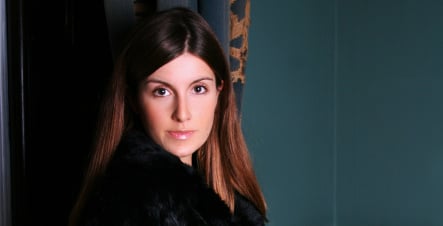Cawthra, 30, is the founder and creative director of Belen Enchandia, a small company that has quickly made a major name for itself in the high fashion world of handbag production.
“We have big ambitions to grow a lot, and I think that we will,” says Cawthra. “When I started this company in 2004 I didn’t set out to fail.”
Cawthra, who was born in northern England, says a trip to Madrid sparked her dream to start the company. After finishing her undergraduate degree in law, she applied for a job at a firm in Spain to gain work experience before starting law school.
She stayed in Madrid for one year, working at the firm in the mornings, nannying in the afternoons, and window-shopping at designer purse stores on weekends. She says she soon realized that nothing similar existed in London, and approached a company to set up sales in England.
“I’m not really fashion crazy, I just saw a business opportunity,” says Cawthra. “Nothing happened for two years, and then I was halfway through my legal practice course back in England and I got an e-mail from that company asking if I was still interested in working with them.”
She says at that point, she realized her calling wasn’t to be a distributor, but to start her own company. Still working in a law firm, she spent every spare moment establishing Belen Enchandia, calling shops like Harrods, Harvey Nichols and Selfridges to tell them about her new company that was different from other mass-produced brands.
“In other luxury brands, the bags are made in China, so bag-making has been turned into an industry rather than an art form,” Cawthra explains. She says some small boutiques showed interest in her bags, but it was a meeting with an editor at www.vogue.com that sent sales through the roof.
“When they posted our first real piece of press, our website had 15,000 hits in 24 hours, and crashed overnight,” recalls Cawthra. “That’s how we got our first international customers.”
Cawthra now has two assistants, based in London, though she moved to Stockholm in March, where her web design team is based. The bags are hand-made by a team of eight in Italy.
She says what’s different about Belen Enchandia is its personalized service given to every customer: the ability to custom-create a bag, interact with a stylist, and know the bag was hand-made for a fair price. The bags are stylish and functional, Cawthra says, and the company is always open to suggestions for improvement.
“We are the only luxury handbag company in the world with a site that lets you design your style, leather, hardware,” says Cawthra. “We interact with our customers. The great thing about being a small company is that we can react very fast. If we have a good idea, we can make it happen in two weeks instead of two years.”
When Belen Enchandia first started, the bags were made in Madrid, where Cawthra had established her first connections as an entrepreneur. But she says her desire to develop and produce new styles caused her to head to Le Marche, Italy, where she could more easily work one-on-one with a smaller atelier.
“About 90 per cent of traditional ateliers have closed because of factories in China taking over,” says Cawthra. “We have an ambition to support these artisans and real Italian manufacturing methods.”
The next step for Belen Enchandia is tapping into the Swedish market, says Cawthra, especially now that she’s living in Stockholm.
“People here are interested in good quality and looking good,” she says. “But I think what’s lacking here is a well-made Italian and international handbag company. The only barrier is people knowing about us, and the VAT (sales tax) which is so high, so it makes the bags more expensive.”
Cawthra says customers often e-mail her to say they are surprised by how much a bag can make them feel special, and that’s when she knows she’s succeeded at her job. She says she has formed friendships with many customers over the years, and is happy to empower them to make decisions – even if about something as seemingly innocent as a handbag.
Her focus is not on having celebrities photographed carrying Belen Enchandia bags, but targeting everyday women who want to be stylish, fashionable and chic without paying an exorbitant amount.
She started the company less than a decade ago, and Cawthra is now the mastermind behind an internationally recognized company, though she says it wouldn’t be ready to take on new challenges – like tapping into the Swedish market – if it weren’t for her team.
“It’s my vision and company, but I feel that I could never do this without everybody who is surrounding me,” says Cawthra. “Everyone needs to feel they contribute to our company’s philosophy of making life beautiful in various ways. It’s more than a business for me, it’s my life.”




 Please whitelist us to continue reading.
Please whitelist us to continue reading.
Member comments